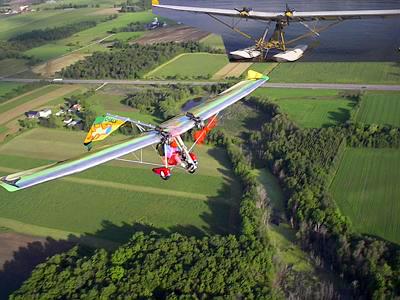|
3.1
ROUTING OF MAGNETO WIRE
When
you mount your engines and connect the magneto grounding wire (the one
which runs back to the kill switch) make sure the wire is routed well
away from the cylinder head. If
it rests against the head, the insulation could melt. causing the wire
to be grounded, and stop the engine.
3.2
ERROR IN AIRSPEED INDICATOR READING
If
you read your copy of "Learning to Fly the Lazair" you're
probably aware that the Hall Brothers airspeed indicator, when mounted
on the fuselage of the Lazair, provides a good relative indication of
airspeed, but does not give an accurate reading in miles per hour.
At take-off speed, the reading Is probably accurate within two or
three miles per hour but at higher speeds, your actual airspeed will be
much higher than Indicated. With a reading of 40 mph, your actual
airspeed will be probably about 55 mph, and this Is the recommended
maximum flying speed.
3.3
LEAKY FUEL FILTERS
As
reported in a previous letter, most of the problems of air bubbles~in
the fuel lines have been traced to the primer bulb.
However, we have had a couple reports of leaks in the fuel
filter. To eliminate this
potential problem, we recommend that the in-line filter be replaced with
the submersible type.
3.4
AILERON PLUGS
One
of our high time demonstrator aircraft has recently developed loose
rivets in the aileron plug P4. This
particular aileron had only four rivets in it rather than eight as
specified in the assembly instructions, so we do not anticipate a
problem on customer-built aircraft, but we do suggest that you check
your aileron plugs occasionally during the walk-around.
3.5
DON'T DO IT IN THE ROCKS
Although
the tail of the Lazair has been designed to withstand the loads imposed
by nommal and very heavy landings it is not indestructible
We have had a report of one aircraft which was taking off from a
rock-strewn field and struck the tall on a large rock at high speed just
prior to take-off. The impact was sufficient to bend the rear stabilizer tube
T1O and dislodge the outboard ruddervator hinge pin. Although the pilot was able to maintain control and land
without incident, this situation should obviously be avoided if
possible. If you have to
take off from a rocky field, remember to keep the tall off the ground.
3.6
CHECK YOUR TAIL
In
the last letter we mentioned the possibility of breaking the rear tail
attach fitting (F4) by landing In very tall grass.
Since it might be possible to break or crack an F4 without being
aware of It, we suggest that you include a check of the F4 in your
walk-around. The most
probable location for a crack, if one should ever occur, is through the
rivet hole. so this area should be checked carefully.
3.7
TIRE PRESSURE
If
you're lucky enough to have the new tundra wheels, remember that they
are designed for Low Pressure tires. The best tire pressure will
depend on the type of field and the weight of the pilot, but should not
under any circumstances, exceed 18 PSI.
3.8
BLUE MAGNETOS
A
few of the engines shipped in the past couple of months have had magneto
Ignition units with a light blue housing.
For some reason, these engines will not always run properly with
the two magnetos' connected to a common grounding switch.
(We suspect that the older units contained a decoupling diode
which has not been installed In the new blue ones, but this
not yet been confirmed by the manufacturer).
In any case, the problem can be eliminated by using a separate
switch for each engine (or by using a double pole switch). To save time, if you have the blue magneto units, we suggest
that you obtain another switch locally, but if you can't locate one, let
us know and we'll send you one.
3.9
AEROBATICS
We
have heard recently that a few customers have been flying loops and
other aerobatic maneuvers In their Lazairs.
While there is no doubt that the Lazair Is capable of executing
some of these maneuvers (as demonstrated by the Ultraflight factory
test pilots), this type of flying is definitely ~not recommended for the
average Lazair pilot. The
Lazair is stressed for 4 g's positive and 2 g's negative.
This is quite adequate for any normal flying conditions but it is
not even close to the stress requirements for fully aerobatic airplanes.
A
properly executed inside loop will probably pull less than 3 g's.
However, a poorly executed loop (one entered at too high an
airspeed or with an abrupt movement on the cont?ol column or one with a
prolonged period of vertically downward flight) could pull well In
excess of the 4 g design limit for the aircraft.
We don't want to hear about someone pulling the wings off in
flighti Accidents of this
type are very easyto avoid - just don't do it.
3.10
IN-FLIGHT RESTARTS
One
of the attractive features of the Lazair is its ability to soar with the
engines off, and then fly home with its engines restarted.
However, restarting these engines in flight is a technique to be
practised and learned only after the basic skills of flying the Lazair
have been mastered. As was suggested in the first of these update letters, your
first attempt to restart in flight should be made at an altitude of at
least 1000 feet. It should
also be made In an area where you can glide to a safe landing should
your restart be unsuccessful.
Although
a restart looks easy when you're on the ground watching someone else do
it, you may find it's a bit different when you're up In the air trying
it yourself. First of all,
it's necessary to lean forward to grasp the pull cord - this can be a
difficult reach for a short-armed pilot.
Leaning forward will change the trim and put the aircraft into a
nose down attitude. This
can be compensated for by a slight back pressure on the stick, but
applying back pressure as you lean forward may not be as easy at first
as you might expect.
In
addition to this, you will probably experience more difficulty starting
the right engine because this requires operating the control column with
your left hand. This is not
necessarily easy - especially if you've never done it before.
Above
all, remember one thing - Fly the Airplane.
Regardless of what the engines are doing, your number one
priority is to maintain some semblance of straight and level flight.
When you're starting an engine, don't look at it - watch where
you're going. And one other word of advice - don't forget to turn on the
magneto switch. This may sound ridiculous, but even a very experienced
pilot will forget occasionally. If
you don't believe this, ask John Moody who couldn't get his engine
started while demonstrating the restart capability of his Easy Riser to
the crowds at Oshkosh this year.
3.11
MYLAR LIFE
The
life expectancy of the mylar used to cover the Lazair is proving to be
very difficult to predict. One of our demonstrators which has been hangared when not
flying, has survived three years with no visible signs of deterioration,
while two owners who have had their airplanes tied down in direct
sunlight have reported mysterious rips in the mylar in the first year. One of these is believed to be the result of vandalism, but
the other appears to be a degradation of the mylar caused by exposure to
ultraviolet radiation from the sun.
Another Lazair, which was left outside during most of last summer
was tested for mylar deterioration by having a 180 pound man walk on the
wing and it withstood this with no damage.
Obviously
factors other than the duration of the exposure to sunlight will
determine the life of the mylar - the intensity of the ultraviolet
radiation (a function of latitude and atmospheric conditions) the angle
of incidence, and perhaps even the manner in which the heat shrinking
was done, could affect the longevity of the mylar.
Based
on experience gathered to date, we
can offer the following suggestions:
Keep your airplane in
a hangar or trailer when not in use.
If a hangar is not
available and disassembling your airplane to put it into a trailer after
every flight is impractical, make some wing covers from vinyl or fabric.
If your airplane is protected as suggested in (a) or (b) above,
replace the mylar every two years.
If your airplane is not protected from ultraviolet radiation,
recover at least the top surface of the wing every year and the rest of
the mylar every two years
Test the strength of the mylar occasionally by slapping It
soundly with the flat of your hand.
Recovering
your Lazair is relatively inexpensive and can easily be done in a
weekend, so doing it every two years or even once a year should not be a
serious burden.
3.12
CYLINDER HEAD BOLTS
We
have received two reports of cylinder head bolts working loose.
Considering the number of engines now In use and the total flight
hours accumulated, two loose bolts would not indicate a serious problem
but it does suggest that the bolts should be checked occasionally and
should be re-torqued after the first five hours running time.
The recommended torque is 8 foot pounds.
3.13
HOLEY MUFFLERS BATMAN!
Pilots
flying Lazairs from high altitude airports can get a bit more thrust to
compensate for the reduced air density by drilling four 3/8"
diameter holes in the top of each muffler.
This will increase the maximum propeller speed by approximately
150 RPM, but since It also produces a corresponding increase in noise,
it is not recommended unless you're sure you need the extra thrust.
3.14
RE-USE OF ELASTIC STOPMUTS
Since
elastic (or Nylock) nuts gradually lose their grip if they are
repeatedly installed and removed, it is
recommended
that the nuts on the Lazair (N3 and N4) be replaced by new ones after
they have been removed three times
3.15
CUSTOMER DESIGNED MODIFICATIONS
We
have seen and been told about many modifications being made to Lazairs.
Some of these are good and some are not so good.
The modifications which are of greatest concern are those which
involve drilling holes in tubing. The
bend strength of a tube is drastically reduced by drilling a hole
through It not
just as a direct function of the reduction In cross section1 but
much more because of stress concentration.
There
is also a considerable difference in bend strength depending on the
location of the hole (whether it is on the neutral or quadrature axis).
Unless you are very sure that you understand the effects of
drilling a hole, don't do it.
Tubes
where additional holes must not be drilled under any
circumstances are the wing struts and the main axle. If you have already
drilled holes In the 1 1/4" axle tube, and you're not planning to
Install the new wheel and axle kit, let us know and we will send you a
new 1 1/4" axle.* **
If
you have one of the first fifty Lazairs (with the bicycle ~eat), there
will be a hole through the center of the axle for the seat support tube.
Although there has never been a reported problem in this area,
the safety factors for a high g flight or landing load are not as high
as we would like after watching the way some Lazairs are flown.
If you have a Lazair with the bicycle seat, please let us know
and we will send you an inner sleeve** to strengthen the mid-section of
the axle.
*
Please specify the length.
|



